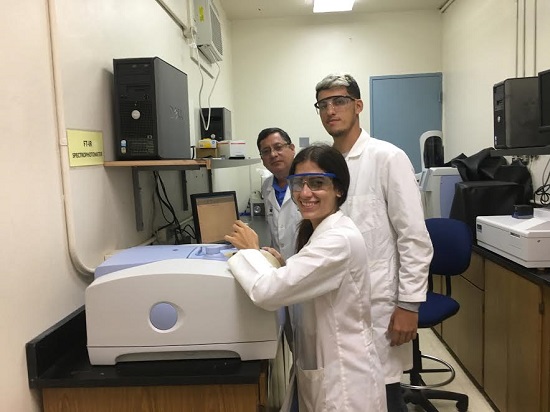Meet Dr. Ricardo Infante, Omar Lourido-Canales and Annette Medina-Valentin
Faculty-Student Team Investigated the Detection of Explosives Particles on Cotton and Polyesters Fabrics
An important aspect of national security and a key priority for the Department of Homeland Security (DHS) is the effective detection of explosives. New technologies to trace explosives are being researched to provide a more secure environment by detecting people that have recently been in contact with or handled explosives. This summer, University of Puerto Rico at Arecibo faculty member Dr. Ricardo Infante and students Omar Lourido-Canales and Annette Medina-Valentín, had the opportunity to research methods to detect high energetic materials (HEMs) (explosives) in eleven different types of fabrics by using both Quantum-Cascade-Laser-Reflection-Absorption-Infrared-Spectroscopy-Grazing-Angle-Probe (QCL-RAIRS-GAP) and attenuated total reflection (ATR)-Fourier-transform infrared (FTIR) spectroscopy methods.

Dr. Ricardo Infante, Omar Lourido-Canales and Annette Medina-Valentin, made possible through the U.S. Department of Homeland Security (DHS) Summer Research Team (SRT) Program for Minority Serving Institutions, travelled to the Center of Excellence for Awareness & Localization of Explosives-Related Threats (ALERT) at the University of Puerto Rico-Mayaguez in Mayaguez, Puerto Rico. The Center of Excellence for ALERT, led by Northeastern University, develops new means and methods to protect the Nation from explosives-related threats.
The faculty-student team, made possible through the U.S. Department of Homeland Security (DHS) Summer Research Team (SRT) Program for Minority Serving Institutions, travelled to the Center of Excellence for Awareness & Localization of Explosives-Related Threats (ALERT) at the University of Puerto Rico-Mayaguez in Mayaguez, Puerto Rico. The Center of Excellence for ALERT, led by Northeastern University, develops new means and methods to protect the Nation from explosives-related threats.
The SRT Program is designed to increase scientific leadership at Minority Serving Institutions in DHS research areas by providing faculty and student research teams the opportunity to conduct research at university-based DHS Centers. The SRT Program and DHS Centers are sponsored by the DHS Science and Technology Directorate Office of University Programs.
The goal of the team’s research was to determine if a QCL-RAIRS-GAP system can be used to detect and quantify HEM on a variety of fabrics with different compositions. GAP sensing at or near the grazing angle (angle of incidence > 80°) enables the phenomenon termed RAIRS-GAP. Fabrics for testing were chosen based on what people wear on a daily basis, with emphasis on cotton and polyester. Omar and Annette weighed fabric samples, prepared HEM’s solutions at different concentrations, and recorded the resulting spectra of the solution soaked fabric samples using both QCL-RAIRS-GAP and ATR-FTIR spectroscopy for comparison. Processing of the data collected from both instruments revealed that traces of HEMs were found on the fabric samples using both instruments. Close analysis of the resulting data revealed that a QCL in RAIRS mode is capable of detecting small amounts of explosives, as low as micrograms, on fabrics. This research brings a new trace remote detection system, QCL-RAIRS-GAP, to the table.
The impact of developing QCL-RAIRS-GAP through this effort is crucial to the explosives sensing community in defense and security applications. With enhanced detection methods, the chance of explosive devices being detected during transport is increased, making U.S. borders safer.
For Infante and students, a favorite part of the program was the exposure to new technologies in the field of vibrational spectroscopy. QCL is an emerging technology and the development of this new application will be critical in future defense and security applications. For students Lourido-Canales and Medina-Valentín, improving their technical skills and networking were some of the most important aspects of the program. “I gained skills with new instruments that I had never used before and I also improved old skills,” Medina-Valentín reflected. “This opportunity is excellent for my future because in interviews for graduate schools and work, they look at what experiences and skills you gain during your college years.” Infante reflected on the importance of the teams’ work, “I firmly believe that to the extent that we create new technology that helps the prevention of acts against innocent people, we are making a safer world.”
The DHS SRT Program is funded by DHS and administered through the U.S. Department of Energy’s (DOE) Oak Ridge Institute for Science and Education (ORISE). ORISE is managed for DOE by Oak Ridge Associated Universities.
